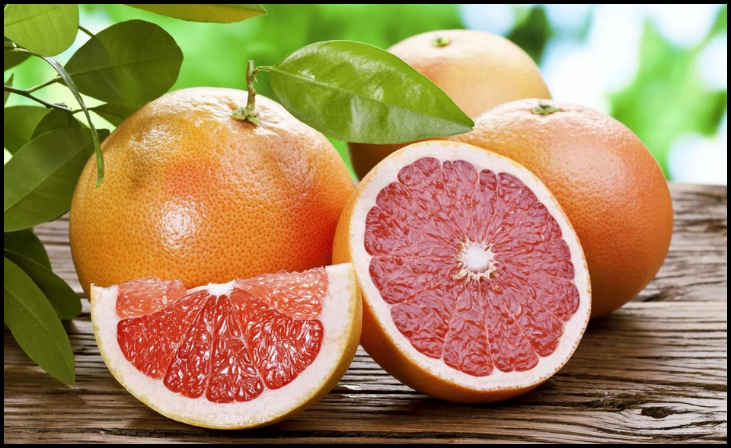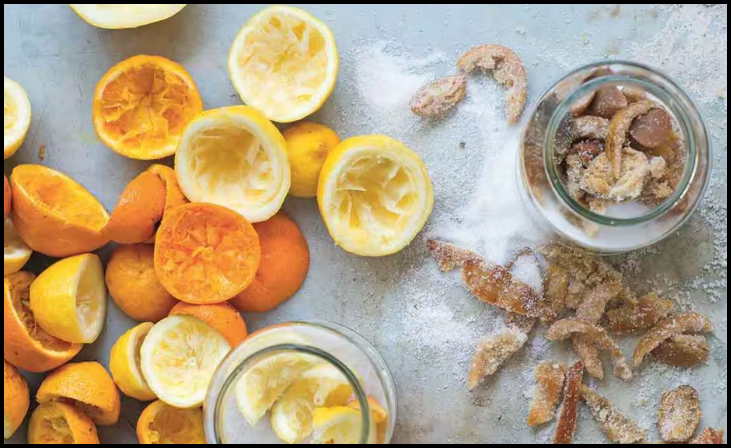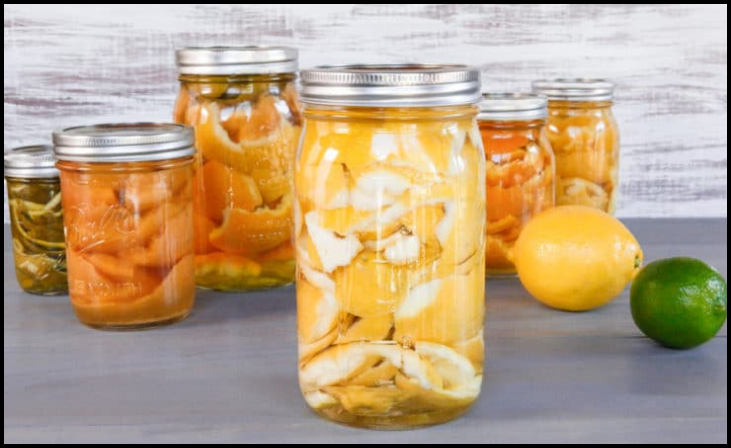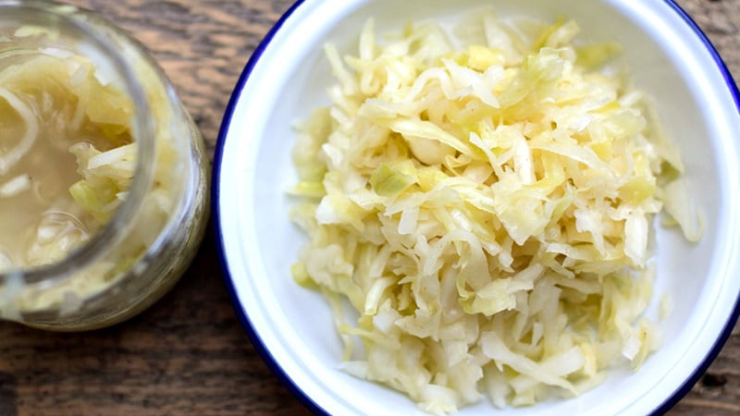Introduce your readers to the mouthwatering world of Citrus Hint Sauerkraut. This blog unveils an innovative twist on the traditional sauerkraut recipe, infusing it with the zesty goodness of citrus fruits. In the realm of fermented foods, sauerkraut stands as a probiotic powerhouse, renowned for its digestive and immune-boosting benefits. However, the Citrus Hint Sauerkraut takes it a step further by blending the nutritional advantages of sauerkraut with the vibrant flavors of citrus.
In this blog, we will guide you through the steps of crafting your very own Citrus Hint Sauerkraut, making the process accessible even to beginners. We’ll explore the choice of citrus fruits, the art of shredding cabbage, and the delicate balance of salting and layering. With a fermentation period, the flavors harmonize, creating a tangy and nutritious delight.
So, whether you’re a sauerkraut enthusiast or simply seeking a delicious and healthful addition to your meals, this Citrus Hint Sauerkraut recipe promises a delightful culinary adventure.
Table of Contents
ToggleWhat is Sauerkraut?
Before diving into the recipe, let’s have a quick look at the basics. Sauerkraut is a traditional fermented cabbage dish that originated in Germany. It’s made by fermenting finely chopped cabbage with salt, which encourages the growth of beneficial bacteria. These probiotics offer numerous health benefits, including improved digestion and a stronger immune system.
For More- A Szechuan-Inspired Mala Pickle Recipe
Ingredients
Here’s what you’ll need for this delightful sauerkraut:
- 1 medium-sized cabbage
- 2-3 citrus fruits of your choice
- 2-3 tablespoons of sea salt
- A glass or ceramic fermentation vessel
- A weight or a smaller jar to press the cabbage
The Citrus Twist
1. Choosing Your Citrus

When it comes to making Citrus Hint Sauerkraut, the first and most exciting step is choosing your citrus fruits. This crucial decision allows you to personalize the flavor profile of your sauerkraut. You have a delightful array of options to experiment with, including the bright and zesty tang of oranges, the sunny and refreshing notes of lemons, or the slightly bitter and aromatic grapefruits.
Each citrus variety brings its unique character to the sauerkraut, infusing it with a burst of fruity goodness. Your choice of citrus not only influences the flavor but also adds a nutritional dimension, as citrus fruits are rich in vitamin C and antioxidants.
So, whether you prefer a sweet and tangy sauerkraut or one with a bold and zesty kick, the choice of citrus is your opportunity to craft a sauerkraut that perfectly suits your taste preferences.
2. Preparing the Citrus
Preparing the citrus is a crucial step in the process of creating Citrus Hint Sauerkraut. Before you can infuse the sauerkraut with the vibrant citrusy flavors, it’s essential to ensure your citrus fruits are ready for action. Start by thoroughly washing the citrus fruits to remove any dirt or residues on the skin. Once they are clean, slice the fruits into thin rounds.
The thinness of the slices is key to ensure that the citrus flavors are evenly distributed throughout the sauerkraut. It’s during this step that the citrus starts to release its aromatic oils, which will mingle with the cabbage during fermentation, creating a delightful burst of flavor.
Whether you prefer a stronger or subtler citrus taste, the thickness of your slices can be adjusted to your liking. Preparing the citrus marks the beginning of the transformation from ordinary sauerkraut into the unique and zesty Citrus Hint Sauerkraut.
3. Shred the Cabbage
Shredding the cabbage is a critical step in the preparation of Citrus Hint Sauerkraut, as it sets the foundation for the entire recipe. To create this delightful dish, you need to start with a medium-sized cabbage head. Using a sharp knife or a mandolin slicer, you should carefully and finely shred the cabbage into thin pieces.
The goal here is to achieve uniformity in the size of the shreds, which will ensure even fermentation and flavor distribution. Shredding the cabbage not only makes it easier to work with but also allows it to release its natural juices when combined with salt in the next steps. These juices play a pivotal role in the fermentation process, as they create the brine that preserves and flavors the sauerkraut.
So, the art of shredding the cabbage is the first creative step in transforming simple cabbage into the star ingredient of your Citrus Hint Sauerkraut, ready to absorb the vibrant citrus notes and evolve into a tangy masterpiece.
Don't just scroll, subscribe!
BuzzTrail's unique web-stories are the cure for boredom you've been waiting for.
4. The Salting Process

The salting process is a fundamental step in the creation of Citrus Hint Sauerkraut. After finely shredding the cabbage, it’s time to introduce sea salt into the equation. The sea salt serves a dual purpose – it not only enhances the sauerkraut’s flavor but also initiates the fermentation process. When you sprinkle the salt evenly over the cabbage and begin massaging it in, you’re kickstarting a transformation.
This process draws moisture from the cabbage, creating a natural brine. The salt acts as a catalyst, encouraging the growth of beneficial lactic acid bacteria. These bacteria are the key to fermentation, as they preserve the sauerkraut and impart its distinctive tangy taste. As you massage the salt into the cabbage for 5-10 minutes, you’ll notice the cabbage softening and releasing liquid.
This liquid will eventually submerge the cabbage, creating the ideal conditions for the fermentation magic to happen. The salting process is the gateway to the world of sauerkraut, where salt becomes the agent of transformation, turning humble cabbage into a probiotic-rich delicacy with a hint of citrus zest.
5. Layering
Layering is a pivotal step in the creation of Citrus Hint Sauerkraut. After the cabbage has been expertly shredded and salted, it’s time to embark on the journey of crafting layers within your fermentation vessel. This process adds a delightful burst of citrusy goodness to your classic sauerkraut. Begin by placing a layer of the salted cabbage in your chosen glass or ceramic fermentation vessel.
On top of this layer, introduce a layer of your citrus fruit slices, ensuring they are evenly distributed. This alternating pattern continues, with cabbage followed by citrus slices, until your vessel is filled. These layers are crucial for evenly distributing the citrus flavors and the beneficial bacteria that will initiate the fermentation process.
The harmonious combination of the cabbage and citrus creates a unique flavor profile that sets Citrus Hint Sauerkraut apart from the traditional version. As you proceed with the layering, you’re on the path to crafting a tangy, probiotic-rich sauerkraut that will elevate your culinary creations.
6. Weight It Down
The step of weighting down your Citrus Hint Sauerkraut is a pivotal element in the fermentation process. Once you’ve carefully layered the cabbage and citrus slices in your fermentation vessel, the next step is to ensure that everything remains submerged beneath the brine. This is where the weight comes into play. Placing a weight or a smaller jar on top of the layers of cabbage and citrus serves two essential purposes.
Firstly, it helps to press the ingredients down, squeezing out any trapped air, which is crucial for a successful fermentation.
Secondly, it keeps the cabbage and citrus from floating to the surface, ensuring that they remain immersed in the brine throughout the fermentation period. This controlled environment is where the magic happens, as beneficial lactic acid bacteria work their fermentation wonders, transforming the ingredients into delicious and tangy Citrus Hint Sauerkraut. The weighted-down vessel, covered with a clean cloth or paper towel, creates the perfect conditions for flavor development and probiotic growth, resulting in a delightful and healthful end product.
7. The Waiting Game

Once you’ve carefully prepared your Citrus Hint Sauerkraut by layering the cabbage and citrus, pressing it down with a weight, and covering it, it’s time to play the waiting game. Fermentation is a patient process, and during this time, your sauerkraut undergoes a remarkable transformation. You’ll want to place your fermentation vessel in a cool, room-temperature location, away from direct sunlight, and leave it undisturbed for at least 1-2 weeks.
As the days pass, the lactic acid bacteria naturally present on the cabbage and citrus will begin their work. They consume the sugars and produce lactic acid, which preserves the sauerkraut and creates that distinctive tangy flavor. The waiting period allows the flavors to harmonize, with the citrus infusing its zesty notes into the cabbage, resulting in the unique taste of Citrus Hint Sauerkraut.
The Benefits of Citrus Hint Sauerkraut
This zesty twist to traditional sauerkraut offers more than just a delightful flavor. It combines the probiotic benefits of sauerkraut with the vitamin C and antioxidants found in citrus fruits, enhancing its nutritional value.
- Improved Digestion: The probiotics in sauerkraut promote a healthy gut, aiding digestion and nutrient absorption.
- Boosted Immunity: The vitamin C from citrus fruits strengthens your immune system, helping you fend off illnesses.
- Fresh and Tangy Flavor: The citrus infusion adds a zingy twist to the sauerkraut, making it a delightful addition to your meals.
Also Read- A Sourdough Kefir Waffle Recipe
Conclusion
In conclusion, Citrus Hint Sauerkraut offers a delightful twist on the traditional sauerkraut recipe. This easy-to-make dish combines the health benefits of probiotics with the vibrant flavors of citrus fruits. The process is not only simple but also highly rewarding. As you craft your own batch, the layers of cabbage and citrus, the salting process, and the waiting game all come together to create a tangy and nutritious masterpiece.
The result is a sauerkraut that not only elevates your culinary creations with its zesty citrus burst but also supports your digestive health and boosts your immunity. Whether you’re a sauerkraut enthusiast or new to the world of fermented foods, Citrus Hint Sauerkraut promises to be a flavorful and healthful addition to your meals.
FAQs
How long does Citrus Hint Sauerkraut stay fresh?
How long does Citrus Hint Sauerkraut stay fresh?
Citrus Hint Sauerkraut can stay fresh for several months when stored in a cool and dark place. Refrigeration can further extend its shelf life.
Can I use different citrus fruits together?
Can I use different citrus fruits together?
Absolutely! Combining various citrus fruits can create a unique flavor profile for your sauerkraut.
Can I adjust the salt content to my taste?
Can I adjust the salt content to my taste?
Certainly! You can adjust the amount of salt according to your preference, but ensure it’s sufficient to initiate the fermentation process.
What are some serving suggestions for Citrus Hint Sauerkraut?
What are some serving suggestions for Citrus Hint Sauerkraut?
You can enjoy Citrus Hint Sauerkraut as a side dish, on sandwiches, or as a topping for salads to add a burst of flavor and probiotics to your meals.

